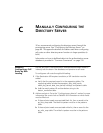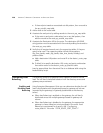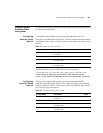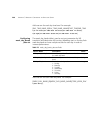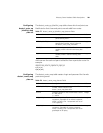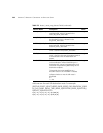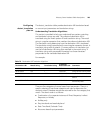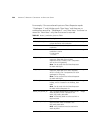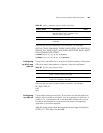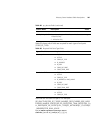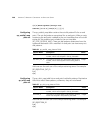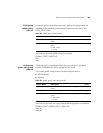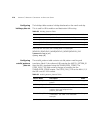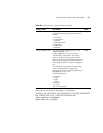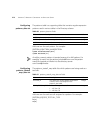
Directory Server Database Table Descriptions 265
Add one row for each destination URI translation. For example:
|DESTURI_TRANS_ID|NAME|ACTIVE|REQ_INDIR_ID|REQ_DIR_ID|HOLIDAY_
ID|WEEK_DAY_BAND_ID|DAY_TIME_BAND_ID|DATETIME_BAND_ID|PATT
ERN_ID|TRANSLATION_STRING
2|TRAN1|1|-1|-1|-1|-1|-1|-1|2|334*|
3|TRAN2|1|-1|-1|-1|-1|-1|-1|3|5551212|
Configuring
ep_blist_map
_data.txt
The ep_blist_map table lists an end point’s blacklist patterns. Destination
URIs must match these patterns, otherwise, they are not allowed.
Add one row for each end point black list pattern. For example:
|EP_ID|PATTERN_ID
1|5|
2|7|
Configuring
ep_data.txt
The ep table creates an end point. An end point can be assigned to be
either a what is called an end point, such as a gateway. An end point is
usually a Tier 1 component that is the destination element for a route.
End points are assigned to routes and are returned to the signaling
application in the route response.
Table 83 shows which fields are required for each type of end point
(CODE_EP_TYPE) within the ep table.
DATETIME_BAND_ID This is a unique identification number for the
date time band, which is located in the
datetime_bands_data table.
Integer
PATTERN_ID This is the destination URI matching pattern. String
TRANSLATION_STRING Determines how the destination URI will be
translated.
String
Table 80 desturi_translation_data.txt Fields (continued)
Column Name Description Value
Table 81 ep_blist_map_data.txt Fields
Column Name Description Value
EP_ID This is a unique end point identification number,
which is found in the ep_data table.
Integer
PATTERN_ID This is a unique pattern identification number, which
is found in the pattern_data table.
Integer



